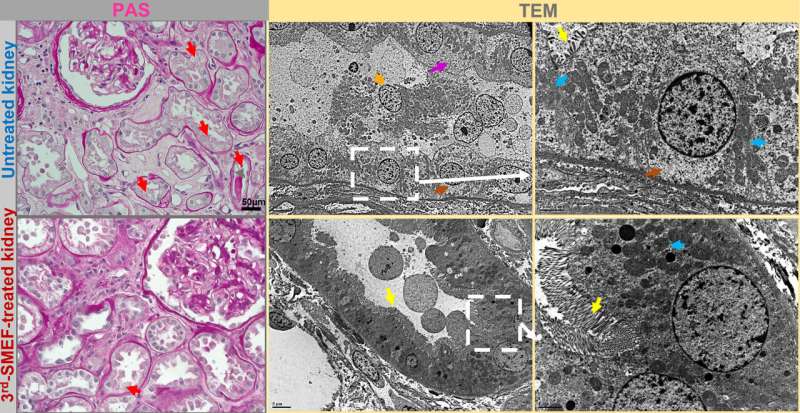March 10, 2022 report
Inhibiting ischemic damage to donated kidneys using a synchronization modulation electric field

A team of researchers affiliated with several institutions in the U.S., has found that applying a synchronized modulation electric field to mouse kidneys can reduce damage due to ischemia-reperfusion injury. In their paper published in the journal Science Translational Medicine, the researchers describe their approach and how well it worked when transplanting kidneys into mice and the results when it was used on unsalvageable human kidneys.
Currently, the only "cure" for patients with severely damaged or diseased kidneys is a transplant—an approach that has saved countless lives. Unfortunately, for some patients, the transplant does not go as planned when the organ fails. This is quite often due to ischemia-reperfusion injury.
In ischemia, cells in an organ such as a kidney are damaged due to loss or restriction of blood flow, usually a result of putting donated organs in a very cold environment. But there is also a related problem—ischemia-reperfusion injury, in which sodium-potassium (Na/K) pumps quit working properly, leading to problems with the cellular production of adenosine triphosphate. This in turn leads to problems maintaining sodium and potassium levels inside of cells. As a result, cells swell and damage other chemicals inside the cell, leading eventually to organ failure.
In this new effort, the researchers noted that prior research had shown Na/K pumps can be impacted by exposure to an electric field. They wondered if applying an electric field to donated kidneys could restart these pumps once they have stopped working properly. To find out, they developed an improved version of a synchronization modulation electric field (SMEF) technique that involves the use of electric energy to synchronize the function of Na/K pumps.
Testing with mice showed the technique reduces damage due to ischemia-reperfusion injury by 54%. They also tried it on 5 of 10 donated human kidneys that were too damaged for use transplants. All of the kidneys were first cold-stored for 24 hours. The researchers then dissected the kidneys and studied their cells under a microscope. They found that those treated with the SMEF technique had undergone less damage. They also found that they could modulate the electric field to control the pumping rates of the pumps.
More information: Wei Chen et al, Reducing ischemic kidney injury through application of a synchronization modulation electric field to maintain Na + /K + -ATPase functions, Science Translational Medicine (2022). DOI: 10.1126/scitranslmed.abj4906
© 2022 Science X Network

















